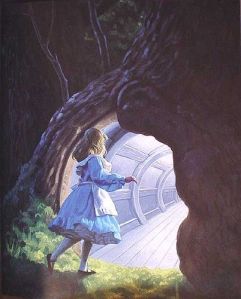“You shouldn’t set foot in there unless you believe in yourself.” (The Cat Returns)
Girls Underground is the name I chose to describe a certain archetype I’ve identified, primarily in modern stories but also originating in fairytales and even myths, which focuses on a female protagonist’s initiatory journey. The core storyline is as follows:
A young girl, who is orphaned or has distant parents, enters the Otherworld/Underworld, often because of a foolish mistake or wish, most notably resulting from dissatisfaction with her life. She is initially aided or guided by a creature from that world. She usually acquires (or brings along) more than one companion, often otherworldly beings or animals, and together they navigate a strange path of labyrinthine nature. They are thwarted along the way by an adversary and the adversary’s minions (a sort of complement to her companions). If the adversary is male (as he often is in the older archetype), there can be some romantic/sexual aspect to their relationship. During the journey, the girl is sometimes drugged, and/or spends some time forgetting herself. She interacts with people or things that are somehow connected to her ‘normal’ life at home, or briefly returns home in the middle of the journey. There is often an issue of time running out, or time behaves strangely. When she nears her goal (the rescue of a loved one, returning to her home, saving the world, or occasionally a personal transformation), she is separated from her companions for awhile, culminating in a one-on-one showdown with the adversary, which frequently involves exposing a fraud (and sometimes resisting his attempts at seducing her to his side). In the end, she is changed irrevocably.
Of course, not every example follows this to the letter, but it is remarkable how many do. There are some further details not always present but still notable in their frequency. The girl, for instance, is most often in the age range of around seven, thirteen, or sixteen. The “otherworld” can often be contained entirely within a house or palace. Her companions are most often male, be they human, animal or magical creature. Sometimes there is a feint regarding who is the real adversary, and/or a betrayal from one of her companions. When the girl is younger, the adversary tends to be a woman, whereas the adversary is more likely a man if the girl is a teenager. There is sometimes an interlude in a place filled with junk. Talking doors make frequent appearances. The girl must solve riddles to keep going. Most of the time, she goes home in the end, but there are some wonderful examples where she stays in the otherworld, or at least maintains a connection to it. Occasionally, it is revealed that she was originally from that otherworld, and/or that she has always been greater than she thought.
“If that is the way it is done, then that is the way you must do it.” (Labyrinth)
An archetype that has already been identified and bears some resemblance to the Girls Underground story is called “The Maiden’s Tragedy.” In his book Creation of the Sacred, Walter Burkert discusses this, saying it “has been said to provide a ‘model for the surface level of the narrative structure of the female fairy tale,'” with its roots in stories like Persephone and Psyche. He details several important motifs in this archetype: “a sudden break in a young girl’s life, when some outside force makes her leave home;” “a period of seclusion….or she may be roaming through the wilderness;” “the catastrophe that upsets the idyll, normally caused by the intrusion of a male, in most cases a special male, a demon, hero or god who violates the girl;” “a period of tribulation, suffering, and punishments;” and finally “she is rescued and there is a happy ending.” One of the most significant differences between this and the Girls Underground story, which is also present in most fairytale predecessors, is that the girl is eventually rescued rather than being the agent of her own fate.



